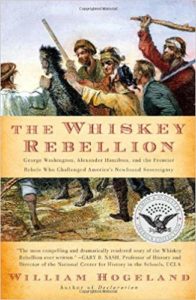

I’ve been at my cottage in Canada since last Monday. Thus the drop off in blog posts.
I’ve been doing a lot of reading and so the next few posts will be comments on the most interesting parts of books I’ve read.
The three books I’ve finished so far are:
- William Hogeland, The Whiskey Rebellion.
- Eleanor Anderson, Miracle at Sea: The Sinking of the Zamzam and Our Family’s Rescue.
- James W. Stewart, Sinking of the Zamzam: Diary of James W. Stewart with the British American Ambulance Corps.
In this post, I’ll focus on #1.
My economic historian friend Jeff Hummel, an economics professor at San Jose State University, recommended the book. It opened my eyes to a lot of things I didn’t know. I had heard briefly about the Whiskey Rebellion of western Pennsylvania, but I hadn’t known how serious it was, how violent it was, and the role that Alexander Hamilton, then the Treasury Secretary, played.
I’m not taking sides here. If I had been around at the time with the views I have now, I would have been against the whiskey tax. That part is easy. But the more extreme of the protestors used pretty violent tactics against western Pennsylvanians who were neutral or on the other side but who didn’t do anything against the protestors.
On the other side was the might of the federal government. Alexander Hamilton was, if you share my view of the tax and of the harsh measures used to collect it, one of the main villains on that side.
Some excerpts:
Optimism and charm crashed periodically into a cold rage that did not rob him [Hamilton] of energy and orderliness. He had, in Philadelphia [then the capital of the U.S.] a department taking up a city block, complete with both the largest on-site bureaucracy in the government and many collectors and inspectors in the field. [p. 112]
Hamilton began musing aloud about enforcing the law not through normal judicial process but through a military expedition directed by the executive branch. [p. 115]
Washington found petitioning at least as disturbing as attacks. He authorized Hamilton to push Attorney General [Edmund] Randolph to get indictments against attendees of the second Pittsburgh convention, whose daring extralegality, Washington assured Hamilton, would be checked by the full force of executive power. Randolph, however, noted that while the attack on [Captain William] Faulkner’s house did provide a cause of legal action, the Pittsburgh convention did not. Assembling to remonstrate, Randolph reminded Hamilton, is among the rights of citizens. [pp. 124-125]
And finally:
Hamilton resolved this dissonance between orders and reality. He made theft legal. The quartermaster corps, he announced, would impress civilian property along the way. Now families watched helplessly as bayonet-wielding soldiers—no longer freelancing thieves but officials, authorized by the president—commandeered hard-won winter supplies of grain, meat, firewood, and blankets on behalf of the United States. A steady, freezing rain meant the arrival of winter. Families whose sustenance was carted away faced grim months ahead. [p. 218]
P.S. I notice that co-blogger Bryan Caplan highly recommends buying and reading Radical Markets by Posner and Weyl. If it wasn’t clear from an earlier post I did on EconLog, I don’t.

READER COMMENTS
Jon Murphy
Jul 22 2018 at 8:47pm
Just those quotes sound fascinating. I added the book to my Amazon shopping list!
At my current pace and workload, I should get to the book sometime in the year 3045.
Comments are closed.